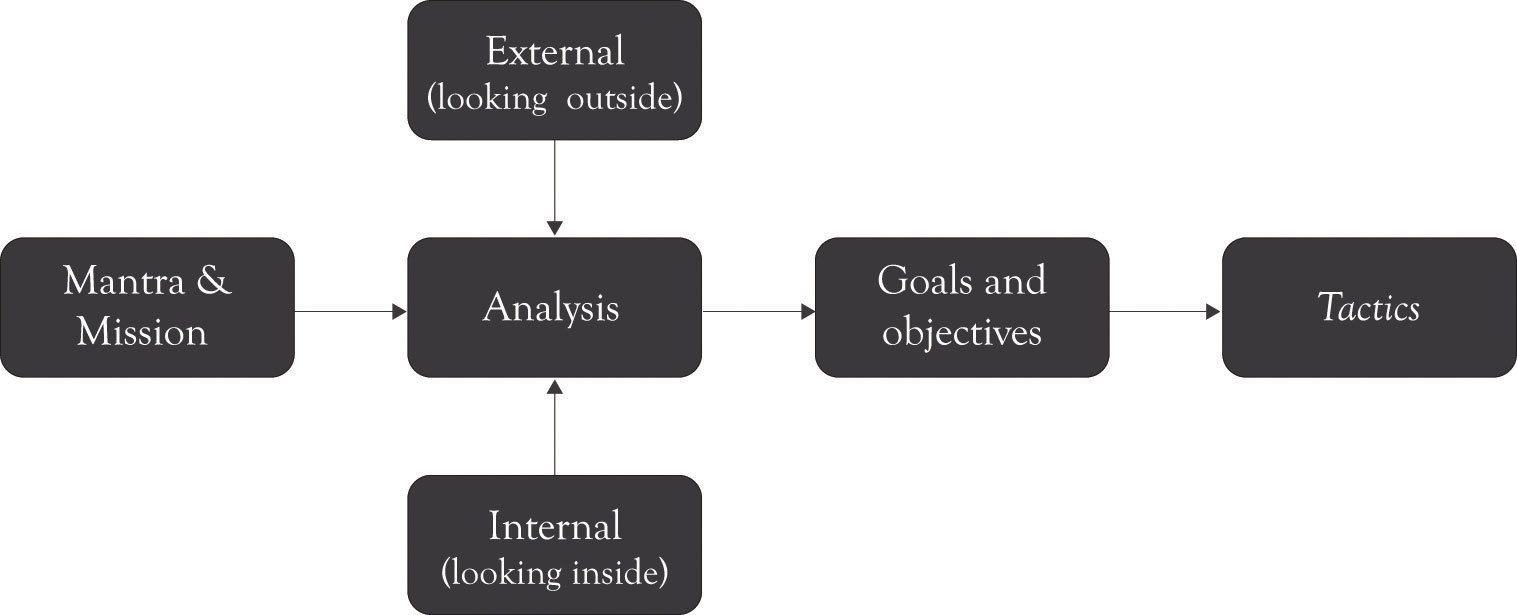This is “The Planning Process”, section 8.2 from the book Creating Services and Products (v. 1.0). For details on it (including licensing), click here.
For more information on the source of this book, or why it is available for free, please see the project's home page. You can browse or download additional books there. To download a .zip file containing this book to use offline, simply click here.
8.2 The Planning Process
Planning can be accomplished in a variety of ways. Figure 8.1 "The Planning Process (Adapted from May)" presents a typical model of the strategic planning process.Adapted from May (2010). The mantraAn often-repeated phrase that provides the basis for a company’s existence. is an often-repeated phrase that provides the basis for the existence of the company. It is a slogan, a watchword, a byword, or a motto that breathes life into the firm’s existence. The mantra is not a replacement for the mission statement. The missionAn overall view of the business at an abstract level. It describes what the company does, why it exists, and how it satisfes customer needs. statement is an overall view of the business at an abstract level. It describes what the company does and why it exists and how it satisfies customer needs. The mission statement can also include a statement reflecting whether the company will focus on product differentiation and niche markets, focus on being price-competitive, or focus on both. The mantra and the mission are rarely static but ever-changing and emerging throughout the life of the firm.
The essence of the planning process consists of looking-inside and looking-outside analysis. AnalysisInvolves both introspection and extrospection. involves both introspection and extrospection. The internal and external organization environments are examined using a number of analytical approaches, several of which are included in Table 8.1 "Orientations of Strategic Planning Approaches". These techniques will be covered in the next section. There is a lot of confusion related to identifying goals and objectives. Many view the terms goals and objectives to be interchangeable. GoalsMore abstract and broader than objectives. are more abstract and broader than objectives. ObjectivesMore detailed than goals. are generally more detailed. The important point that will be discussed in the next chapter is to identify the goals and objectives that will help support the mantra, the mission, and the value proposition over a certain time frame. The tacticsThe activities the organization will use over the next three months to a year to reach their goals and objectives. are the activities the organization will use over the next 3 months to a year to reach their goals and objectives. The tactics can include timetables and schedules related to the goals and objectives. The key to the model in Figure 8.1 "The Planning Process (Adapted from May)" is that this is not a linear process. Sometimes a new mission emerges after analysis has been completed. Mission statements that change, reflect an organization that can adapt to dynamic environments.
Figure 8.1 The Planning Process (Adapted from May)

Table 8.1 Orientations of Strategic Planning Approaches
| Inter organizational focus | External competitive environments focus | Time to execute | |
|---|---|---|---|
| Value and supply chain analysis | High | Low | Moderate |
| Porter’s five force model | Low | High | Long |
| Resource-based framework | High | Moderate | Long |
| Strategy maps | High | Moderate | Long |
| Creating Blue Ocean markets using the strategy canvas | Moderate to high | Moderate to high | Short |
| SWOT analysis | Moderate to high | Moderate to high | Short |
We will revisit the definitions in the next chapter and illustrate how the planning process can be streamlined and made more efficient and facilitate the development of business plans in a very short time span using the Ten–Ten planning process.




